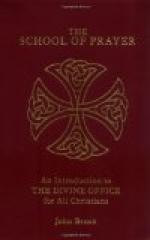TRINITY SUNDAY.
The first Sunday after Pentecost, for centuries, was not called Trinity Sunday. Pope Alexander II. (circa 1073) was questioned about a feast in honour of the Holy Trinity and he replied that it was not the Roman custom to set apart any particular day in honour of the Trinity, which was honoured many times daily in the psalmody, by the Gloria Patri. But an Office and Mass, dating from a hundred years earlier than this Pope’s time, were in use in the Netherlands and afterwards in England, Germany and France; and in 1260 were spread far and wide. In 1334, Pope John XXII. ordered uniformity and general observance of this feast on the Sunday after Pentecost. The Office in our Breviaries dates from the time of Pius V. It is beautiful and sublime in matter and in form. Whether this is a new Office or a blending of some ancient offices, is a matter of dispute. Baillet, Les Vies des Saints (Tom ix. c. 2, 158) thinks it a new Office. But Binterim, Die Kirchichle Heortology, Part I., 265, and Baumer-Biron, Histoire du Breviaire, 298, take a different view. The Roman rite follows the older form of enumeration, second Sunday after Easter and so forth, and not first Sunday after Trinity. The latter form of enumeration is adopted in the Anglican church service books.
THE PROPER OF THE SAINTS.
December. The Feast of the Immaculate Conception. The discussion of the question of this feast lasted for more than a thousand years. A feast of the Conception was celebrated in the Eastern Church in the early part of the eighth century and was celebrated on the 9th December (Kellner, Heortology, p. 242, et seq.). The feast was celebrated in England before the Norman Conquest (1066) (Bishop, On the Origins of Feast of the Conception of the Blessed Virgin Mary, London, 1904).




